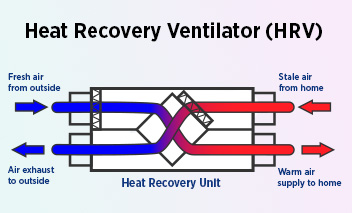HRV Buying Guide: What Features to Look For
Just How Heat Recovery Ventilation Boosts Indoor Air High Quality and Reduces Energy Prices
Heat Recovery Ventilation (HRV) systems play a crucial function in boosting interior air top quality while all at once decreasing energy costs. By efficiently trading stagnant indoor air with fresh exterior air, HRVs assist maintain ideal moisture and minimize pollutants. Furthermore, their ability to recover warmth from outbound air minimizes the pressure on heating and cooling systems. As power costs continue to rise, understanding the full potential of HRV systems ends up being significantly essential for homeowners and businesses alike.
Comprehending Heat Recovery Ventilation Equipments

Heat recovery ventilation (HRV) systems play a necessary function in improving interior air high quality, specifically in modern, energy-efficient structures. These systems are designed to transfer warmth from the outbound stale air to the incoming fresh air, consequently decreasing power loss while keeping excellent temperature degrees inside your home. HRVs are composed of a heat exchanger, fans, and ductwork, assisting in the continual circulation of air. By removing indoor contaminants and presenting fresh air, HRVs help to balance humidity levels, stop mold growth, and lower allergens. The efficiency of HRV systems hinges on their ability to recoup up to 80% of the heat from the exhausted air, promoting power preservation while making sure a healthy indoor setting. Their integration is vital in attaining sustainable living methods.
The Value of Indoor Air High Quality
Indoor air quality (IAQ) is an important aspect influencing the health and well-being of owners in any type of environment. Poor IAQ can bring about different wellness problems, including respiratory system troubles, allergies, and fatigue. In addition, it can worsen current problems such as bronchial asthma. Elements adding to reduced IAQ include toxins from interior sources like cleansing agents, mold and mildew, and poor air flow. Subsequently, preserving excellent IAQ is crucial for promoting a safe and comfortable living or functioning area. Efficient strategies to enhance IAQ entail routine surveillance of air high quality, correct ventilation systems, and decreasing using harmful compounds indoors. By prioritizing IAQ, people can guarantee a healthier setting that promotes productivity and total high quality of life.
Energy Effectiveness Conveniences of HRV Equipments
Many property owners and building supervisors are progressively recognizing the energy efficiency advantages of warm recuperation air flow (HRV) systems. By transferring heat from exhausted interior air to inbound fresh air, HRV read the full info here systems markedly minimize the power required for heating & cooling. This procedure reduces reliance on typical heating and cooling systems, bring about lower power expenses. Furthermore, HRVs help preserve a well balanced indoor environment, avoiding extreme heating or cooling down demands. The capability to recuperate approximately 90% of the warmth from outgoing air likewise supports sustainability initiatives by lowering overall energy consumption. As a result, HRV systems add not just to set you back financial savings but also to a decreased carbon footprint, straightening with the growing focus on energy-efficient building methods.
Setup and Upkeep Considerations
The efficient implementation of heat recuperation air flow (HRV) systems needs mindful consideration of setup and maintenance aspects to guarantee peak performance. Correct positioning of the HRV system is necessary, as it should be set up in a location that maximizes air flow while lessening sound disturbance. Additionally, ductwork needs to be properly sized and insulated to stop power loss. Regular upkeep, including filter replacement and system cleansing, is crucial to safeguard ideal performance and indoor air high quality. Proprietors ought to develop a normal maintenance routine to recognize and attend to potential problems prior to they rise. Collaboration with knowledgeable specialists during both setup and upkeep stages can enhance the longevity and effectiveness of HRV systems, inevitably bring about far better indoor environments and decreased power prices.
Real-World Applications and Success Stories
Discovering real-world applications of heat recovery ventilation (HRV) systems exposes their considerable influence on interior air top quality and power performance across different setups. In household buildings, house owners have actually reported better air top quality, causing fewer allergies and respiratory system problems. Schools carrying out HRV systems have actually have a peek at this site noted boosted student focus and lowered absence as a result of far better air flow. Industrial buildings, such as offices and retail spaces, have experienced reduced power expenses and boosted staff member efficiency. As an example, a company workplace in a warm climate achieved a 30% decrease in power expenses after installing an HRV system. These success tales demonstrate that HRV technology not just adds to much healthier environments however also gives substantial monetary advantages, making it a useful financial investment for various markets.
Frequently Asked Inquiries
Can HRV Equipments Decrease Allergens in Indoor Air?
The performance of HRV systems in reducing interior allergens largely depends upon their capacity to filter and exchange air. HRV Heat Recovery Ventilation. By continually replacing stagnant air, these systems can significantly decrease irritant levels throughout interior atmospheres

Just How Does Humidity Affect HRV System Performance?
Humidity greatly influences HRV system performance; high levels can cause condensation, decreasing performance, while reduced moisture may improve air exchange. Balancing moisture is vital for perfect procedure and preserving indoor air top quality.
Are HRV Systems Noisy During Procedure?
HRV systems can create differing noise degrees throughout procedure, depending upon their layout and installation. Some units run quietly, while others might generate obvious noise, specifically at higher air movement settings or when poorly maintained.
What Is the Average Life Expectancy of an HRV System?

Can HRV Solutions Be Used in All Environments?
HRV systems can be used in numerous environments, yet their efficiency might vary - HRV Heat Recovery Ventilation. In extreme temperatures, adjustments or additional systems may be needed to guarantee suitable performance and comfort while keeping indoor air top quality